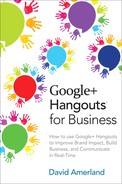References and Resources
There are remarkably few resources to turn to on the web when it comes to Hangouts and Hangouts on Air. As you’d expect, your go-to resource pages have to be Google and Ronnie Bincer (who was this book’s technical editor).
• Get started with Hangouts On Air: http://goo.gl/xAAvn
• Google+ Features: http://goo.gl/CZBCu
• Google Education—Hangouts On Air: http://goo.gl/v0MEp
• Ronnie Bincer on Google+: http://goo.gl/wps24v
• Ronnie Bincer YouTube page: http://goo.gl/JGUOi
• Ronnie Bincer Blog: http://goo.gl/ajBq5
Chapter 1
Christensen, Clayton M. (1997), “The Innovator’s Dilemma: When New Technologies Cause Great Firms to Fail,” Harvard Business Review Press.
Foresight (2013), “Future of Identity,” Department for Business, Innovation & Skills and Government Office for Science. http://goo.gl/hDEcU8.
Perritaz, Damien; Christophe Salzmann; and Denis Gillet (2009), “Quality of Experience for Adaptation in Augmented Reality” SMC ‘09 Proceedings of the 2009 IEEE international conference on Systems, Man and Cybernetics, Pages 888-893.
Chapter 2
Ben-Akiva, M.; M. Bierlaire; H. N. Koutsopoulos; and R. Mishalani (2002), “Real Time Simulation of Traffic Demand-Supply Interactions within DynaMIT,” Transportation and Network Analysis: Current Trends, Springer.
Dornbush, S., (2006) “Streetsmart Traffic: Discovering and Disseminating Automobile Congestion Using Vanet’s,” Master’s thesis, University of Maryland, Baltimore County, Aug.
Chapter 5
Manyika, James and Dobbs, Richard (2013), “Disruptive Technologies: Advances that Will Transform Life, Business, and the Global Economy,” McKinsey report, May: http://goo.gl/cvhKZ.
“Talking to Strangers: Millennials Trust People over Brands,” Bazaar Voice, January 2012: http://goo.gl/fVvXYq.
Chapter 6
Har Gill, Amir (2010), “A Failed Success: A Community Television Case Study of the Contradictory Nature of Participation and Deliberation,” International Journal of Communication, 4, 778–798.
Chapter 7
Aaker, Jennifer L. and Durairaj Maheswaran (1997), “The Effect of Cultural Orientation on Persuasion,” Journal of Consumer Research, 24, 315-328.
Aaker, Jennifer L. and Patti Williams (1998), “Empathy vs. Pride: The Influence of Emotional Appeals Across Cultures,” Journal of Consumer Research, 25, 241-261.
Abramson, Neil R., Robert J. Keating, and Henry W. Lane (1996), “Cross-national Cognitive Process Differences: A Comparison of Canadian, American and Japanese Managers,” Management International Review, 36 (2), 123-146.
Arnould, Eric J. and Craig J. Thompson (2005), “Consumer Culture Theory (CCT): Twenty Years of Research,” Journal of Consumer Research, 31 (4), 868-882.
Murphy, Patrick E, (2010), “Business Ethics and Marketing Ethics: Good News and Bad News,” Business Ethics Quarterly, 20, October (4th Quarter/Autumn), 751-753.
Murphy, Patrick E, (2010), “Marketing Ethics at the Millennium: Review, Reflections and Recommendations,” University of Notre Dame, Mendoza College of Business, study.
Reid, Veronica (2011), “A Study of the Influence of Individual-Level Cultural Value Orientation on the Formation of Service Quality Expectations,” Nottingham University Business School Thesis.
Sorley, Jason (2009), “The Three Percent Club,” The Hub, 31-33: http://goo.gl/v55RFW.
“The Influence of Culture on Climate Change Adaptation Strategies: Preferences of Cross-Country Skiers in Austria and Finland,” Journal of Travel Research, January 1, 2014, 53, 96-110.
Zhang, Jingyun; Sharon E. Beatty; and Gianfranco Walsh (2008), “Review and Future Directions of Cross-Cultural Customer Services Research,” Journal of Business Research, 61, 211-224.
Zhang, Yong and Richard Buda (1999), “Moderating Effects of Need for Cognition on Responses to Positively versus Negatively Framed Advertising Messages,” Journal of Advertising, 28 (2), 1-15.
